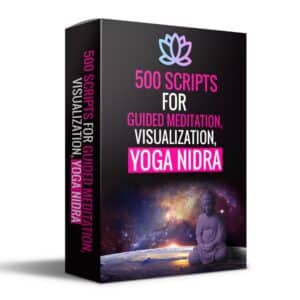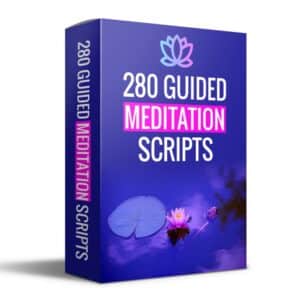Guided meditation is a great way to relax, reduce stress and anxiety, and enhance your overall well-being. It can help you focus your thoughts, cultivate positive emotions, and find inner peace. If you want to create a guided meditation, you’ve come to the right place. In this ultimate guide, we’ll show you how to create a guided meditation that’s effective, engaging, and meaningful. We’ll cover the essential steps, techniques, and tips that will help you make the most of your meditation practice.

Why Guided Meditation is So Powerful?
Meditation has been around for centuries and is widely known for its multitude of benefits, including reduced stress and anxiety, increased focus and creativity, and improved overall well-being. However, not everyone finds it easy to meditate on their own, which is where guided meditation comes in. In this blog post, we’ll explore why guided meditation is so powerful and how it can transform your life.
1. Guided meditation helps you stay focused
When you meditate on your own, it’s easy to get distracted by your thoughts and lose focus. Guided meditation sessions provide an anchor for your mind, helping you stay present and focused on the present moment. This helps you to overcome distractions and stay on track with achieving your meditative goals.
2. Guided meditation reduces anxiety
Anxiety is a widespread problem that affects millions of people worldwide. It is often caused by negative thoughts and an overactive mind. Guided meditation helps to calm the mind and reduces negative and racing thoughts, which in turn reduces anxiety levels. Additionally, it helps you to develop a more positive outlook and ways of thinking, further boosting your mood and your ability to cope with stressful situations.
3. Guided meditation enhances creativity
When you find yourself stuck in a creative rut, guided meditation can help. By focusing on the present moment and tuning out distractions, you can tap into a powerful source of inspiration. Through guided meditation, you can enhance your imagination and creativity and unlock your creative potential.
4. Guided meditation fosters personal growth
Guided meditation offers a platform for self-reflection and self-discovery. By becoming more self-aware, you can identify your strengths and weaknesses and work towards personal growth and development. Guided meditation helps you build resilience, patience, and inner strength, which are essential qualities for personal growth.
5. Guided meditation improves overall well-being
Ultimately, guided meditation is extremely beneficial to your overall well-being. It can help to reduce the symptoms of stress, anxiety, depression, and other mental health issues. It can also help you sleep better and improve your physical health, reducing the risk of heart disease, high blood pressure, and other conditions.

What Makes a Good Guided Meditation?
Guided meditation has been the talk of the town for some time now. More and more people are getting interested in it to help them cope with stress, anxiety, and negative thoughts. However, not all meditation guides are created equal. Some can be ineffective, dull, or even counterproductive. So, what makes a good guided meditation? Let’s explore the key elements that can make or break a guided meditation session.
1. Clarity of Instructions
A good meditation guide must provide clear and concise instructions to the listener. This includes cues on how to breathe, relax, visualize, and focus. If the instructions are vague or ambiguous, it can lead to confusion, frustration, or distraction, and take away from the benefits of the meditation practice. A good guide must also pace the instructions with enough pauses to allow the listener to absorb and follow through.
2. Authenticity and Empathy
A good meditation guide must be authentic and empathetic in its delivery. He or she must be sincere and genuine in their intention to help the listener and avoid sounding laconic or robotic. The guide must also show empathy toward the listener’s feelings and struggles, acknowledge them, and offer positive and inspiring words of encouragement.
3. Appropriateness
A good guided meditation must be appropriate for the listener’s needs and preferences. The guide must take into account the listener’s level of experience, cultural background, and tastes, and provide a meditation style that suits them. For instance, some people prefer a silent meditation, while others prefer a guided one with music or sounds. Similarly, some people might want to focus on mindfulness, while others might want to do more visualization exercises.
4. Creativity
A good guided meditation must also be creative and imaginative. The guide must use a variety of sensory and emotional cues to transport the listener into a relaxed and peaceful state. This can include visualizing positive scenes, using affirmations, or invoking objects or symbols that have personal meaning to the listener. The guide must be able to tell a story that engages the listener’s imagination and distracts them from their mundane worries.
5. Depth and Intention
A good guided meditation session must also have a depth of intention. The guide must not only aim to relax the listener but also to inspire them towards a more positive and meaningful state of being. This can include cultivating qualities like compassion, gratitude, forgiveness, or resilience. The guide must have a clear and consistent intention throughout the session and avoid being preachy or dogmatic.

How Long Should a Guided Meditation Be?
If you are new to guided meditation, you may wonder how long a session should last. Let’s explore the different options and help you find the perfect meditation length for your needs.
First, it’s important to note that there is no one perfect length for a guided meditation. The length of a session will depend on your personal preferences, schedule, and level of experience. That being said, the following are some recommendations to help you find the right length.
1. Short Meditations (5-10 minutes)
If you are new to guided meditation, a short session can be an excellent way to get started. These types of meditations can help you build up your practice gradually, without feeling overwhelmed or frustrated. Short sessions are also a great option if you have a busy schedule, as they can be easily incorporated into your daily routine.
2. Medium-length Meditations (15-30 minutes)
Medium-length meditations offer a good balance between the calming effects of a longer session and the ease of a shorter one. Many guided meditations fall into this category and can be a great option for those who are ready to deepen their practice or seek to quiet an overactive mind. Longer than a short session, but still manageable enough to fit into a busy schedule.
3. Long Meditations (45-60 minutes)
Longer guided meditations can be an incredibly powerful tool for those who are experienced in the practice. A 45-60 minute session can offer a deeper level of relaxation and can help you connect with your inner thoughts, emotions, and feelings. While this length is not recommended for beginners, those with more experience can benefit from creating a regular practice.
4. Extended Meditations (90-120 minutes)
If you are looking for a full-blown meditation retreat, this is the way to go. Extended meditation sessions offer a unique opportunity for deep relaxation, introspection, and self-awareness. However, it’s important to remember that extended sessions are not for everyone; they can be physically and mentally challenging, and require a serious commitment of time.

Can Anyone Write a Guided Meditation?
To start with guided meditation, it is essential to prepare yourself with two critical elements: a voice that can soothe and engage the participants. A well-trained voice can take a participant on a journey and help them experience relaxation and calmness.
Anyone can write a guided meditation. However, while creating a guided meditation, it is vital to keep in mind the objective of this practice. The purpose is to help people relax, meditate, and achieve a mindful state. A guided meditation should allow the participants to visualize and calm their thoughts. To create a successful guided meditation, it is essential to choose a peace triggering theme and follow a specific pattern that allows the participants to unwind.
Anyone can write a guided meditation, but it’s essential to follow specific techniques to make the meditation effective. Writing a successful guided meditation requires the writer to develop a comfortable atmosphere for the practitioners to achieve a calm and relaxed state.

What Do You Need to Create a Guided Meditation Recording?
Creating a guided meditation recording is a great way to share your practice with others or create a meditation practice for yourself.
To create an effective meditation recording, you will need a script, high-quality recording equipment, soothing music and sound effects, and editing software. With these components, you can create a meditation recording that is both calming and effective.
1. Script
The most critical element in creating a guided meditation recording is the script. Your script should be concise, clear, and easy to understand. You should aim to use language that evokes a sense of calmness and relaxation. Avoid using complex sentences and concepts that can cause confusion or distract from the meditation experience.
2. Recording Equipment
Once you have your script, you will need to record your voice. The quality of your recording will significantly impact the effectiveness of your guided meditation recording. You will need a high-quality microphone to capture your voice and audio editing software. Some popular options include Audacity, Adobe Audition, and GarageBand.
3. Music and Sound Effects
Adding soothing, calming music or sound effects to your guided meditation can enhance the meditation experience. You can find free or royalty-free music and sound effects online that are perfect for meditation recordings. Make sure to choose music that complements the theme and tone of your meditation recording.
4. Editing
Once you finish recording your guided meditation, you will need to edit it. This step involves cutting out unwanted background noise, equalizing the sound, and mixing the audio tracks. You can also add music and sound effects at this point.
5. Sharing
Once you have your finished guided meditation recording, you can share it with others in several ways. You can create a YouTube video, upload it to your website or blog, or sell it on platforms like iTunes and Amazon.

How to Write a Guided Meditation Script?
The heart of your guided meditation is the script. The script is the narrative that you will use to guide your listeners through the meditation. It should be clear, concise, and engaging. It should include a description of the theme, the steps of the meditation, and the visualization techniques. Use simple language and avoid jargon. You can include music or sound effects to enhance the ambiance. Practice reading your script aloud to ensure that it flows smoothly and has the right tone.
Writing an effective guided meditation script requires creativity, empathy, and a solid understanding of the requirements of the intended audience. Following these five tips should help you develop an excellent guided meditation script that helps people lower their stress and enhances their mental well-being. Remember, practice makes perfect, so keep trying and experimenting to discover what works for you.
1. Define Your Goals
The first step to writing an outstanding guided meditation script is to be clear about your goals. What do you want your meditation script to accomplish? Is your objective to help your listeners relax or sleep, to reduce anxiety or depression, or to develop a deeper level of spirituality? Do you want to reduce stress, improve focus, cultivate compassion, or connect with your inner self? Once you’ve determined your goal, you can focus on creating a script that aligns with that purpose.
2. Choose the Right Setting
The setting of your script is critical to its effectiveness. Imagine your listeners in a quiet space where they can escape the distractions of their daily lives and focus on their concerns. Choose a location and environment that exacerbates the theme of your meditation script. For example, a guided meditation script that focuses on relaxation would work well in a serene, natural environment.
3. Use Appropriate Language
The language you use in your script should be simple, calming, and conducive to relaxation. Refrain from using complex vocabulary, and instead, choose words that resonate with your listeners. Tone of voice, when building your script, is also essential because it sets the mood and the pace of the meditation. Consider using a peaceful and guiding tone, or adjust your tone to fit the energy of different parts of the script.
4. Incorporate Sensory Details
Incorporating sensory details in your guided meditation script helps your listeners visually immerse themselves in the experience. Adjust the language so that listeners can feel the texture of objects they are imagining, smell and hear the surroundings, feel the temperature, and engage all of their senses to make the experience more vivid.
5. End with Affirmations
Finally, a guided meditation script should end with affirmations that encourage your listeners to carry the positive energy and peacefulness with them after the meditation is over. Affirmations work so well because they help program your listeners’ minds to divert some of the negative energy into positive energy and thinking. Encourage them to repeat these affirmations, throughout the day or every time they need help with mindfulness.

Where to Buy Guided Meditation Scripts?
Guided meditation scripts can be an excellent tool to help guide practitioners through meditation sessions. However, finding the right place to purchase high-quality guided meditation scripts can be challenging.
When it comes to using guided meditation scripts, the importance of high-quality scripts cannot be ignored. Low-quality scripts can be distracting and unhelpful, producing a counterproductive effect and defeating the purpose of meditation. That’s why it’s crucial to prioritize high-quality guided imagery scripts.
We are passionate about meditation and philosophy, meaning we create unique and exciting meditation scripts. These scripts are high quality and aligned with specific themes like mindfulness, stress management, and relaxation. If you are looking for unique guided meditation scripts, you’ve come to the right place.
High-quality guided meditation scripts provide a sense of calmness, and relaxation, and reduce stress levels. They can transport practitioners to a place of deep relaxation, like a beach or meadow, making it easier to let go of anxiety and stress. The right script can be a powerful motivation tool, especially for those who have busy lives and need a little nudge to meditate. By stimulating the senses in the right way, high-quality guided meditation scripts can lead to improved self-awareness and emotional stability.
Guided meditation scripts can be accessed through various sources. However, not all sources provide high-quality materials. Some meditation apps or guided meditation websites may offer guided meditation scripts. However, these are often generic and created for the masses, and may not offer the customized guidance you require.

How to Select Music for Your Guided Meditation?
One of the most important factors that can enhance the overall effectiveness of guided meditations is the music that accompanies them. The right type of music for your guided meditation can make a significant difference in how you feel during and after the session.
Whether you’re a beginner or a seasoned practitioner, selecting the right music for your guided meditation is crucial to getting the most out of your meditation practice. Take your time, experiment with different tracks and genres, and observe how they resonate with you. Remember, the goal of a guided meditation is to help you create clarity of mind and promote inner peace, and the right music can make all the difference in achieving this desired state.
1. Why Music Is Important For Guided Meditations
Music can instantly affect our moods, emotions, and thoughts. When properly integrated into guided meditations, it can enhance overall relaxation, create a peaceful environment, and promote a sense of emotional openness and spiritual awareness. Music can significantly help reduce anxiety and stress levels during the guided meditation process. Synchronization of the music to the breathing patterns can significantly improve the quality and duration of the deep relaxation that accompanies meditation. The right type of music can help you create a deeper connection with your inner self and help you stay focused during the guided meditation session.
2. What To Look For In Guided Meditation Music
The first thing to consider while selecting music is to choose the type that resonates with you. This is a central element to finding the right music for your guided meditation and critical to its success. The goal of any meditation is to help you feel calm, centered, and relaxed. Look for gentle pieces of music with soft rhythms and melodies that create a peaceful ambiance. Consider guided meditation music that is repetitive and has a steady rhythm to help you establish and maintain more relaxed breathing and heart rates. Keep in mind that the consideration should not combine vocals that can be distracting but rather focus on instrumental music that sets a tone that helps you self-expand internally.
3. Different Types Of Guided Meditation Music Genres
Music genres include classical, ambient, and nature sounds. Classical music can work great for vivid minds and can draw their focus and attention away from distracting thoughts. It is also known to have therapeutic and healing effects. Nature sounds, on the other hand, can be incredibly immersive and help to create a sense of calm, with the immersive sounds of birds, rivers, and waves crashing against the shore. You can try to select ambient music which creates an ethereal atmosphere and can be relaxing and peaceful, very helpful in letting go of any tension or anxiety.
4. Trying New Music For Your Guided Meditation
Don’t hesitate to test various tracks and genres in search of the one that suits you most. Even though it may require some experimentation and exploration, finding the right music for your meditation is a crucial ingredient for a successful guided meditation. Often, taking some time to daydream, and let your mind wander can assist you in your music selection process and identify what is most instrumental in creating the meditation experience.

Where to Buy Guided Meditation Music?
Practicing meditation requires focus, discipline, and the right environment. One thing that can greatly aid beginners and advanced practitioners alike is guided meditation music. These calming sounds can help you clear your mind, focus on the present, and connect with your inner self. But where can you find the best guided meditation music? Let’s explore some of the best places to shop for meditation music online, so you can start your journey towards peace and relaxation today.
1. iTunes
Apple’s online store is a great place to start your search for guided meditation music. You can browse by genre, album, and artist and download tracks or entire albums to your device. You can also preview each track before buying, so you can be sure it’s the right fit for you. Plus, with Apple’s seamless integration with their products, you can easily listen to your meditation music on your iPhone, iPad, or iPod.
2. Amazon
Amazon is another popular option for purchasing meditation music. You can browse their selection of MP3s and CDs and choose from a variety of genres, including nature sounds, binaural beats, and chanting. Many albums also come with detailed track listings, so you can pick the perfect meditation for your needs. With Amazon Prime, you can also get free shipping on physical CDs and access to additional free music through Amazon Music.
3. Calm.com
While Calm is primarily known as a guided meditation app, they also offer a selection of guided meditations for purchase on their website. These recordings range in length from 5 to 30 minutes and are designed to help you relax, focus, and sleep better. Calm also offers a free trial of their app, which can help you find the right guided meditation music for your needs before you purchase.
4. Mindful Music
Mindful Music is an online meditation music store that specializes in creating calming and inspiring music for meditation and relaxation. Their selection includes albums with nature sounds, classical and acoustic music, and guided meditations. They also offer a free stream of their music so you can sample before you buy. And if you’re planning on using meditation music in a professional setting, such as a yoga studio or meditation center, Mindful Music offers volume discounts on their music.
5. Spotify
If you’re looking for a more budget-friendly option, Spotify offers a wide selection of guided meditation playlists and tracks, all available to stream for free with ads. You can also upgrade to a premium subscription for ad-free listening and additional features. With Spotify, you can browse curated playlists or create your own, making it easy to find the perfect meditation music for your needs.

How to Record a Guided Meditation?
Recording, editing, and producing the guided meditation is a simple process as long as you follow the recommended guidelines. The beauty of guided meditation is that it can be styled to meet your personality as the narrator, and the recording process flexibility allows for experimentation with different meditation techniques. Whether you are a beginner or a professional, creating a guided meditation is a valuable skill that can help improve your mental and emotional health and that of your audience.
Once you have written your script, you can record your meditation. You can use a smartphone, a computer, or a professional recording device. Find a quiet place where you won’t be disturbed, turn off notifications, and use a microphone if possible. Speak clearly and at a moderate pace. Take breaks between sections to give your listeners time to reflect. You can edit the recording later if necessary.
1. Recording the Guided Meditation
The first step in creating a guided meditation is the recording. Quality recordings are essential to provide a pleasant, uninterrupted listening experience without any background noise, breathing, or rustling clothes. Before starting, you need to choose a quiet place that is free from any unnecessary noises. Record your voice using a good-quality microphone, preferably a condenser microphone. It is also essential that you have a script ready to avoid any unnecessary pauses or stammering.
2. Editing the Recording
After you have finished recording, the next step is editing the guided meditation. Typically, editing involves removing any audio errors and mistakes such as background noise or unwanted sounds that may disrupt the listening experience. Some of the popular audio editing software include Adobe Audition, GarageBand, and Audacity, all of which should be sufficient for beginners in audio editing. Some common techniques for editing the recording include cutting out unwanted sections or long pauses, applying fade in/fade-out, and noise reduction.
3. Background Music and Sound Effects
Adding background music and sound effects can enhance the listener’s experience, and there are various resources available on the internet that you can use for free or purchased music and sound effects. When using background music or sounds, make sure it’s royalty-free so that you do not infringe on any copyrights or intellectual property.
4. Producing the Guided Meditation
You’re now ready to produce your guided meditation. Producing includes exporting the audio file in an appropriate format, usually .wav or .mp3, compressing the file size and finalizing the audio quality. You can also choose to add artwork or create visualization to match the meditation theme.

How to Share and Sell a Guided Meditation?
As the demand for guided meditation increases, it is a great opportunity for individuals to channel their creativity and develop their meditation techniques while simultaneously monetizing it.
Creating and selling your guided meditation is an excellent way to channel your creativity and develop your meditation skills. The process requires a bit of effort, and attention to detail is necessary, but once you develop and market your product, it has enormous potential. Remember, authenticity is essential, so create a product that speaks to you and will resonate with your target audience. Continuously enhancing your product and creating transformed experiences will ensure customer success and retention.
The final step is to share your guided meditation with the world. You can upload it to a meditation app, a podcast platform, a video-sharing website, or your own website. Make sure to have a description of the guided meditation, the length, and the theme so that your audience knows what to expect. You can also share it with your friends, family, or community. Be proud of your creation and celebrate your contribution to the collective wellbeing.
To successfully sell and share your guided meditation, you’ll need to target individuals who will appreciate and benefit from your meditation. Social media platforms are an excellent way to reach a large audience. By marketing, the meditation on your social media platforms or influencers, you can attract and retain customers. Additionally, creating your website and incorporating analytics tracks data and measures engagement, which is valuable to developing your product.
The fundamental aspect of your meditation product is continuous improvement, based on the feedback and engagement of your audience. Thus, continually develop your meditation, making changes to improve relaxation and provide a better listener experience. Hosting live streams where you can speak directly with listeners and answer questions can occur. Alternatively, creating a survey to collect feedback and take it into account when updating your meditation can also prove effective.

The Most Common Mistakes With Guided Meditation
Creating guided meditations that resonate with people is not as easy as it seems. Guided meditations are effective when done correctly. However, creating a guided meditation can be challenging, especially with the abundance of available resources online. By avoiding certain mistakes, you can create guided meditations that will resonate with your audience and help them achieve their meditation goals. Remember to take your time, create customized meditations, invest in quality sound, prepare the audience’s mind, and vary the scripts. With these tips, you can create high-quality guided meditations that will leave a positive impact on your audience.
Rushing through the Meditation
One of the most common mistakes with guided meditation creation is rushing through the meditation. It is easy to get caught up in the excitement of creating something new and forget the ultimate goal: relaxation. People listen to guided meditations to calm their minds and reduce stress levels. Thus, it is essential to take your time and focus on relaxation techniques. Start slowly and let the meditation build up to the climax.
Not Considering the Audience
When creating a guided meditation, it is vital to consider the audience. Different audiences have different preferences and expectations. For example, if you are creating a meditation for teenagers, the tone of voice, vocabulary, and topics should be different than when creating a meditation for adults. Additionally, it is essential to create meditations for different skill levels, from beginners to experts. Thus, it is crucial to conduct research on the target audience and create a customized meditation that suits their needs.
Poor Sound Quality
Guided meditations rely heavily on sound quality. If the sound quality is poor, the audience may find it challenging to focus on the meditation. Thus, it is essential to invest in quality recording equipment and ensure that the audio is clear and soothing. Also, make sure to incorporate nature sounds, music, or silence in the meditation to enhance the overall listening experience.
Lack of Preparation
Meditation preparation is about setting the mood for meditation. When creating a guided meditation, it is essential to prepare the audience’s mind for meditation. This involves relaxation techniques such as deep breathing, body scanning, and muscle relaxation. Therefore, prepare the audience’s mind by guiding them through relaxation techniques before beginning the meditation. It is also crucial to create a distraction-free environment that is conducive to meditation.
Repetitive Scripts
Repetitive scripts can make your guided meditations feel monotonous, and the audience may lose interest. Therefore, it is crucial to switch up the script and vary the tone of voice, vocabulary, and background music. Moreover, it would be best to keep the scripts fresh and relevant to the audience’s needs. Sometimes, it’s a good idea to get feedback from your audience to know what they liked or didn’t like.

Final Words
Creating a guided meditation can be a rewarding and inspiring experience. It allows you to tap into your creativity, mindfulness, and compassion. By following these steps, you can create a guided meditation that reflects your intention, resonates with your listeners, and enriches your life. Remember to practice regularly, experiment with different techniques, and seek feedback from others. With time and dedication, you can become a skilled and confident meditation guide. Happy meditating!


![Free Guided Meditation Scripts [PDF]](https://guidedmeditationscript.com/wp-content/uploads/2023/05/Guided-Meditation-Scripts-300x185.jpg)
![Free Visualization & Guided Imagery Scripts [PDF]](https://guidedmeditationscript.com/wp-content/uploads/2023/04/Visualization-Guided-Imagery-Scripts-300x185.jpg)
![Free Yoga Nidra Scripts [PDF]](https://guidedmeditationscript.com/wp-content/uploads/2023/04/Guided-Yoga-Nidra-Scripts-300x185.jpg)



